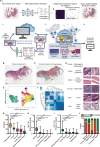PHARAOH: A collaborative crowdsourcing platform for phenotyping and regional analysis of histology
- PMID: 39820318
- PMCID: PMC11739387
- DOI: 10.1038/s41467-024-55780-z
PHARAOH: A collaborative crowdsourcing platform for phenotyping and regional analysis of histology
Abstract
Deep learning has proven capable of automating key aspects of histopathologic analysis. However, its context-specific nature and continued reliance on large expert-annotated training datasets hinders the development of a critical mass of applications to garner widespread adoption in clinical/research workflows. Here, we present an online collaborative platform that streamlines tissue image annotation to promote the development and sharing of custom computer vision models for PHenotyping And Regional Analysis Of Histology (PHARAOH; https://www.pathologyreports.ai/ ). Specifically, PHARAOH uses a weakly supervised, human-in-the-loop learning framework whereby patch-level image features are leveraged to organize large swaths of tissue into morphologically-uniform clusters for batched annotation by human experts. By providing cluster-level labels on only a handful of cases, we show how custom PHARAOH models can be developed efficiently and used to guide the quantification of cellular features that correlate with molecular, pathologic and patient outcome data. Moreover, by using our PHARAOH pipeline, we showcase how correlation of cohort-level cytoarchitectural features with accompanying biological and outcome data can help systematically devise interpretable morphometric models of disease. Both the custom model design and feature extraction pipelines are amenable to crowdsourcing, positioning PHARAOH to become a fully scalable, systems-level solution for the expansion, generalization and cataloging of computational pathology applications.
© 2025. The Author(s).
Conflict of interest statement
Competing interests: The authors declare no competing interests.
Figures



References
-
- Bernard, J., Zeppelzauer, M., Lehmann, M., Müller, M. & Sedlmair, M. Towards user-centered active learning algorithms. Comput. Graph. Forum.37, 121–132 (2018).
-
- Shuyang, Z., Heittola, T. & Virtanen, T. Active learning for sound event detection. IEEE/ACM Trans. Audio Speech Lang. Process.28, 2895–2905 (2020).
MeSH terms
LinkOut - more resources
Full Text Sources

